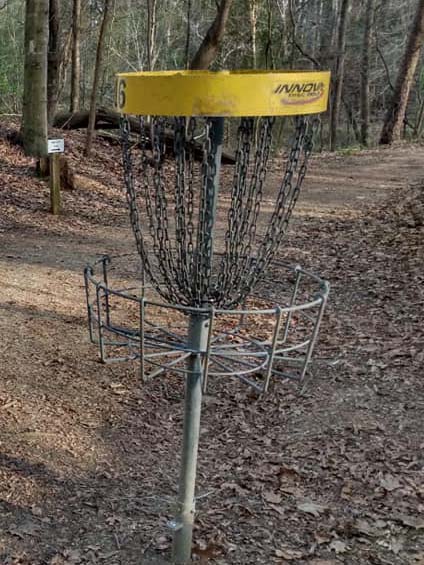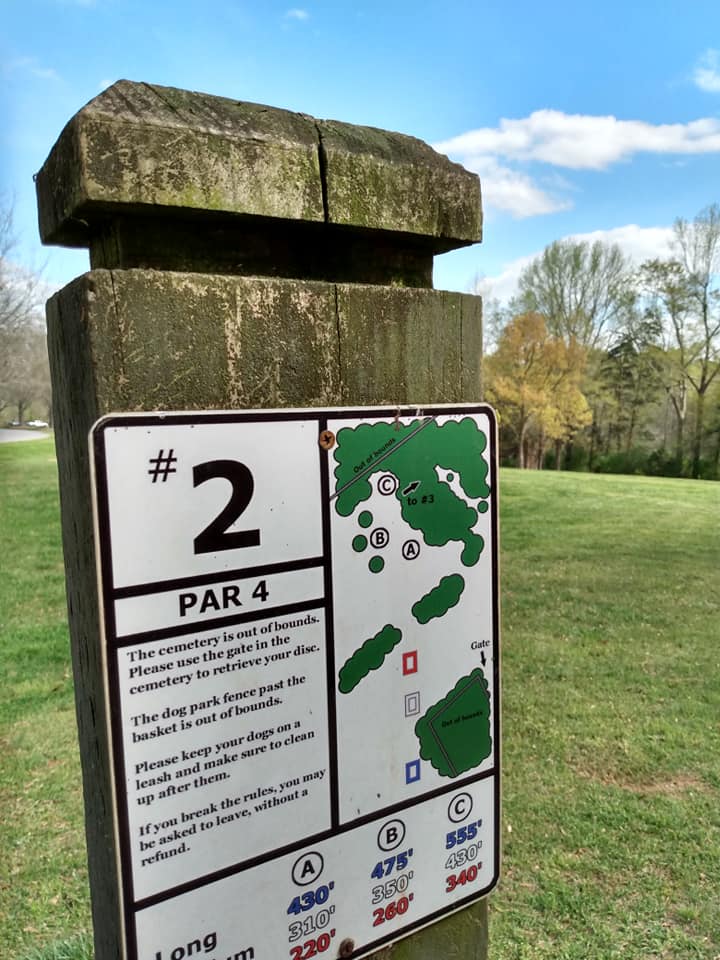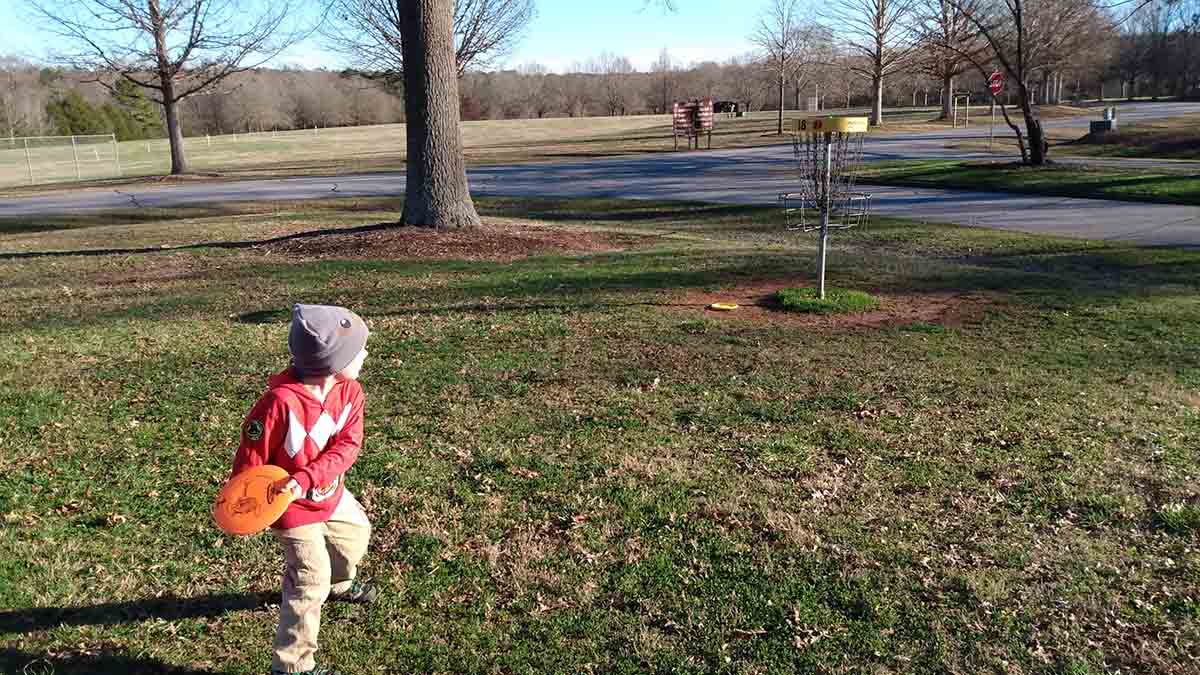“Come on, guys! The next one’s up ahead!” My five-year-old nephew Charlie ran across a wooden bridge spanning a babbling brook. The park was filled with the smell of pine trees and campfires, taking me straight back to childhood. Farther downhill, the lake’s waters lapped at its mossy shores as fishermen leisurely cast lures into the water.
My 66-year-old Dad and I followed after Charlie, each of us holding a stack of multicolored plastic discs. There we were, three generations of Schmidts, hiking across a picturesque park near Athens, Georgia. We had come to play a sport created for all ages and fitness levels, one that is cheap and accessible to all.
We had come to play disc golf.
The premise of the game is simple: you stand on a concrete pad and throw a plastic disc across an extensive distance, aiming for the “hole”: a metal basket on a raised pole, with hanging chains made to catch the disc.
According to Wikipedia, the idea of playing golf with flying discs has existed since the early 1900s. The modern form of the sport, however, was developed in the 1970s by Ed Headrick. A former employee of the Wham-O toy company, Headrick patented the modern Frisbee disc. He and his son Ken would sometimes take their Frisbee discs and sneak into golf courses at night, to practice throwing at different targets: trees, poles, and trash cans. In 1976, Headrick started the Professional Disc Golf Association (PDGA) and began manufacturing special discs; the following year, he patented his special disc-catching basket.

As in traditional golf, disc golfers try to reach the basket in the lowest number of “strokes” possible. Like “the other golf,” this game is a great excuse to enjoy a beautiful day outdoors. Picturesque disc golf courses are as varied as the natural landscapes that surround them.
Since I started playing years ago, I’ve played courses throughout California, Georgia, and even Hawaii. I’ve tossed discs through thick Georgia pine forests hanging with Spanish moss, avoiding water hazards and swampy “slime hazards”; along the shore of lakes where fish jump to catch bugs in the twilight; over dry creek beds lined with chaparral and desert scrub brush. One Hawaiian course overlooks the Honolulu skyline, framed by the shimmering blue Pacific. Play there long enough, and you’re guaranteed to eventually spot a rainbow.
While the courses are beautifully landscaped, this sport has one key difference from conventional golf: it won’t break the bank. There is no need to buy or rent expensive clubs, no country club membership fees. At most, some disc golf courses charge a small maintenance fee. I’ve never paid more than five dollars to play.
To be sure, you can spend quite a bit on the discs themselves. Unlike ordinary Frisbee discs, golfing discs are specially made from thick plastic and molded for different flight patterns. Aficionados often collect dozens of discs, each with subtle variations of thickness and shape: drivers, midrange, and putters.
To get started, however, you really only need two: a driver for long distances, and a putter to toss into the metal basket. You can find these for around $10 each at any used sporting goods store, and many courses have a “pro shop” on site that rents out discs. (The park in Athens, Georgia even lends them out for free.)
Wherever you live, you’re likely not far from a disc golf course. The online PDGA directory lists over 50 courses in Maryland alone, including Scarboro Hills, Seneca Creek, Woodsboro, Mill Brook, and the lovely Summit Lake in the Emmitsburg / Thurmont area. There are courses in nearly every U.S. state and much of Canada. It’s a popular summertime sport in Europe, particularly in Scandinavia, where the sunlight lasts well past 10 p.m. Estonia has the world’s highest concentration of courses per square kilometer of land.

Disc golf is played in at least 40 countries around the world, with courses on every continent — even Antarctica. The McMurdo Flights course is listed on the official PDGA website, including instructions on how to get there: “From Christchurch in New Zealand, hop on a military flight down to ‘The Ice’: McMurdo Station, Antarctica.”
It’s one of the fastest growing sports in the U.S., with over 90,000 active members in the PDGA. Much of its popularity can be attributed to how accessible the game is — particularly for more senior players.
I recently spoke with Don Wallace at San Diego’s Morley Field course. He’s 63 years old, and has been playing since he was 19. Don is a close friend of Snapper Pierson, the creator of the course and its longtime manager. “As I’ve gotten older,” Don told me, “I find new limitations. I used to play Ultimate Frisbee disc, but my ankle and joints won’t let me anymore. But I’m out here throwing discs twice a week, and I always will be. Disc golf is a lifelong sport for me.”
In 1979, Don and Snapper joined the PDGA. They drove up to Huntington Beach to buy one of the first sets of Night Flyer discs, purchased directly from Ed Headrick himself.
“I don’t play tournaments anymore, but I still love it. It’s a great activity for people my age. You don’t have to be the best in the world — it’s all about shooting for your own personal best. You come here to stay active and have fun. There’s no place I’d rather be.”
Players can adjust the intensity to their own personal fitness levels. You’re free to walk the course at a leisurely pace, enjoying the scenery of a finely landscaped park. If you want an extra strenuous workout, on the other hand, you can jog from one hole to the next. Before you know it, you’ll have covered two or three
miles! Meanwhile, the throwing motion strengthens several key areas: shoulders, arms, core, back, and hips, developing greater flexibility. The challenge of aiming for the basket, meanwhile, helps to sharpen hand-eye coordination skills.
When I played with my Dad and my nephew in Georgia, we took it slow. Dad used his aluminum hiking poles to help him across the course, while little Charlie ran ahead of us. It was a languid day at the park, the sun glistening off the lake’s surface, the chatter of cicadas in the distance. As we approached the last basket, Charlie found that his disc had landed four yards away.
“You can always move up closer,” I encouraged him.
“No thanks, uncle. I got this.”
He grabbed the heavy disc in his tiny hand, cocked his arm across the chest, threw it at the basket twice his height … And sank the shot! Dad and I applauded, and we collected our discs and walked back to the car. Charlie took his Grandpa’s hand. “This is a great game for us three to play,” he said with a smile.
I couldn’t agree with him more.
David J. Schmidt is an author, podcaster, multilingual translator, and homebrewer who splits his time between Mexico City and San Diego, California.
Toss your disc!
To find a course near you, search the PDGA online directory: https://www.pdga.com/course-directory/

Let's keep in touch!
Keep up with the latest OutLook by the Bay information by signing up here. We promise not to waste your time.


